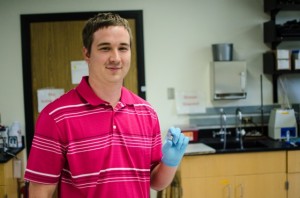Is This Chip the Key to Desalination?
It would be easy to mistake the small, translucent, object in Kyle Knust’s hand as just another cheap piece of plastic. With dozens more scattered around his section of a buzzing graduate assistant’s lab at the University of Texas, the thumbnail-sized chips don’t appear to be worth much.
And that’s because they’re not. At 50 cents apiece, the chips are pretty cheap to make. But the technology inside of them – a method of water desalination that’s potentially cheaper and more efficient than any other – could prove to be invaluable.
Along with other researchers and private companies, Knust is helping to develop a desalinating “water chip” that uses a charged electrode to separate salt from water. The new technique could revolutionize how people get water, as well as how much they pay for it.
Desalination Today
Desalination, the process of removing salt or other particles in order to produce usable fresh water, is practiced around the world with varying degrees of prevalence. It is most common in the Middle East, particularly in arid countries like Saudi Arabia and the United Arab Emirates.
According to the Texas Water Development Board, Texans use approximately 120 million gallons of desalinated water per day, all of which comes from brackish water. Although Texas does not currently have a seawater desalination plant, the Laguna Madre Water District plans to build one on South Padre Island.
Powering the plants and transporting the water often requires the use of fossil fuels, which can be costly and hurt the environment. Waste from desalination can also effect the marine life that lives near the plant itself.
Currently, the most prevalent desalination technique is reverse osmosis, which uses differences in pressure to filter water through a membrane.
Although reverse osmosis can be performed on a large scale, the technique presents certain challenges in terms of cost and efficiency. Microorganisms that live in the water can damage the fragile membranes, so any water run through them must first be pretreated with chlorine, which is expensive.
A Different Way to Desalinate?
The water chip requires neither chlorine nor a membrane to operate. Instead, it uses a tiny metal strip carrying a 3-volt charge to separate salt from water.
The chip contains a Y-shaped channel the width of a human hair. At the split of the Y, the charge from the metal strip creates an electric field. As sea water flows through the channel, it is able to pass through the electric field. But the charged particles (such as salt or microorganisms) are “bumped” to the other channel by the field, effectively desalinating the water.
Since the water chip doesn’t need pretreatment with chlorine or a membrane, experts say it’s a more cost effective way to desalt water. It also requires less energy than reverse osmosis.
Dr. Richard Crooks is the professor overseeing the project. He says that the water chip eliminates many of the problems that have prevented desalination from becoming more common.
“Because of the energy cost, the only reason to desalinate right now is because you have to,” Crooks said. “So anything you can do to bring the energy cost or the total cost down, that’s a good thing.”
But even with these advantages, the system isn’t exactly perfect yet.
Chip Challenges
Drinking water needs to be 99% desalinated in order to be potable, but the device’s current configuration has only reached 25% desalination. Lately, Knust’s main preoccupation has been figuring out how to increase that number.
“Simple things like changing our device heights, altering the design of the electrode, the shape or position of the electrode, we haven’t really played around with any of that at all,” Knust said. “Those will all have key effects on the electric field, which is really what’s controlling the desalination process.”
If Knust is able to increase the degree of desalination though, there’s still the challenge of scaling up the device. Maintaining the device’s energy efficiency is crucial to its development, and researchers are unsure how that will hold up as it gets bigger.
Knust and Crooks have also had to figure out better materials to use, since the seawater would corrode the electrode after only a few uses. Though they’ve had some success with metals like platinum, that may be too expensive for a large-scale production.
Broader Impacts
Despite these challenges, at least one company is betting on the potential benefits that the water chip represents.
Tony Frudakis, the founder and CEO of Okeanos Technologies, started his company in 2010 specifically to build a product around the water chip. He doesn’t mince words on why he decided to do it.
“There’s a dire need for not just incremental improvements to our ability to produce water, but for drastic, paradigm-shifting improvements,” he said. “In essence we’ve taken the first step towards demonstrating that there are more efficient ways to separate salt from water, and globally the implications of that are profound.”
Frudakis is using the principles of Crooks’ and Knust’s design to create a device that can replace current desalination methods. He plans to build “modules” containing millions of desalination units in order to desalt water on a larger scale.
Frudakis says that the product should remove 95% to 99% of the water’s salt. And while Okeanos’ product will look much different than the water chip, the guiding hypotheses behind it are the same.
“It’s a fundamentally different way of desalination. It’s a lot less energetically expensive, and…its potential lays in the operational savings it could provide,” he said.
Frudakis projects that Okeanos’ first prototypes will be ready for field testing by early 2014. He then plans to market the product to established desalination plants as a replacement for reverse osmosis membranes.
For Knust, that will be an opportunity to see his cheap little chip do some very valuable good.
“I think what I really like is the basic science and discovering something new,” he said. “Yes it’s still in its infancy…but it’s something that no one has really pursued previously. The fact that it could have a global impact is exciting.”


